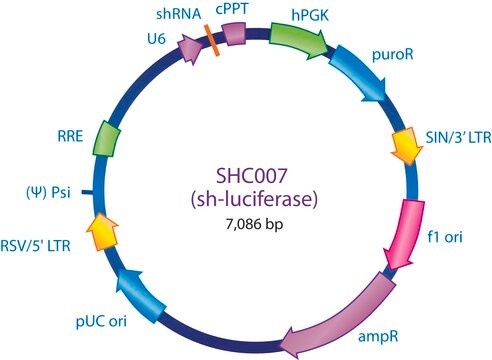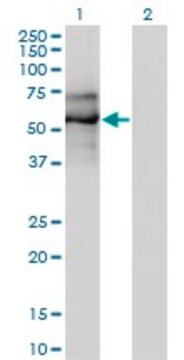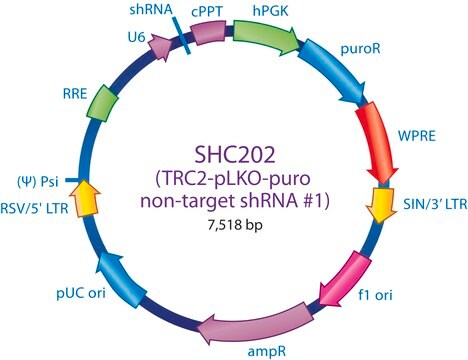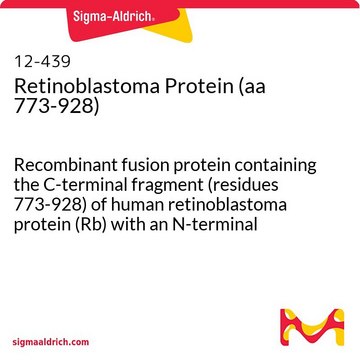SHC007V
MISSION® pLKO.1-puro Luciferase shRNA Control Transduction Particles
shRNA sequence targeting luciferase
Synonym(s):
MISSION®, MISSION® Control Transduction Particles
Sign Into View Organizational & Contract Pricing
All Photos(1)
About This Item
UNSPSC Code:
41106609
NACRES:
NA.51
Recommended Products
Quality Level
product line
MISSION®
concentration
≥1x106 VP/ml (via p24 assay)
technique(s)
capture ELISA: 106 TU/mL using p24
shipped in
dry ice
storage temp.
−70°C
Looking for similar products? Visit Product Comparison Guide
Related Categories
General description
The MISSION Luciferase shRNA Control Transduction Particles contain an shRNA sequence targeting Luciferase, Photinus pyralis (GenBank Accession No. M15077). The Luciferase shRNA Control Particles are useful as a positive knockdown control in experiments using cell lines expressing firefly luciferase.
The Luciferase shRNA control transduction particles are produced from the sequence-verified lentiviral plasmid, pLKO.1-puro-luciferase shRNA (Prod. No. SHC007). Self-inactivating replication incompetent viral particles are produced in packaging cells (HEK293T) by co-transfection with compatible packaging plasmids. In addition, the control transduction particles are pseudotyped with an envelope G glycoprotein from Vesicular Stomatitis Virus (VSV-G), allowing transduction of a wide variety of mammalian cells. 200 μl of 106 TU/ml (via p24 titering assay) lentiviral particles are provided as frozen stock.
The Luciferase shRNA control transduction particles are produced from the sequence-verified lentiviral plasmid, pLKO.1-puro-luciferase shRNA (Prod. No. SHC007). Self-inactivating replication incompetent viral particles are produced in packaging cells (HEK293T) by co-transfection with compatible packaging plasmids. In addition, the control transduction particles are pseudotyped with an envelope G glycoprotein from Vesicular Stomatitis Virus (VSV-G), allowing transduction of a wide variety of mammalian cells. 200 μl of 106 TU/ml (via p24 titering assay) lentiviral particles are provided as frozen stock.
When conducting experiments using MISSION® shRNA clones, the proper controls should be a key element of your experimental design to allow for accurate interpretation of knockdown results. The MISSION Control Transduction Particles are a critical positive control to monitor transduction efficiency.
To see more application data, protocols, vector maps visit sigma.com/shrna.
To see more application data, protocols, vector maps visit sigma.com/shrna.
Application
To see more application data, protocols, vector maps visit sigma.com/shrna.
Legal Information
MISSION is a registered trademark of Merck KGaA, Darmstadt, Germany
recommended
Storage Class Code
12 - Non Combustible Liquids
WGK
WGK 3
Flash Point(F)
Not applicable
Flash Point(C)
Not applicable
Personal Protective Equipment
dust mask type N95 (US), Eyeshields, Gloves
Choose from one of the most recent versions:
Certificates of Analysis (COA)
Lot/Batch Number
Don't see the Right Version?
If you require a particular version, you can look up a specific certificate by the Lot or Batch number.
Already Own This Product?
Find documentation for the products that you have recently purchased in the Document Library.
M N Khan et al.
British journal of cancer, 104(7), 1151-1159 (2011-03-10)
Clear cell renal cell carcinoma (CCRCC) is the commonest form of kidney cancer. Up to 91% have biallelic inactivation of VHL, resulting in stabilisation of HIF-α subunits. Factor inhibiting HIF-1 is an enzyme that hydroxylates HIF-α subunits and prevents recruitment
Krijn R Vrijsen et al.
Advanced healthcare materials, 5(19), 2555-2565 (2016-08-30)
To date, cellular transplantation therapy has not yet fulfilled its high expectations for cardiac repair. A major limiting factor is lack of long-term engraftment of the transplanted cells. Interestingly, transplanted cells can positively affect their environment via secreted paracrine factors
Mariano J Alvarez et al.
Nature genetics, 50(7), 979-989 (2018-06-20)
We introduce and validate a new precision oncology framework for the systematic prioritization of drugs targeting mechanistic tumor dependencies in individual patients. Compounds are prioritized on the basis of their ability to invert the concerted activity of master regulator proteins
Ruth S Cruz Cosme et al.
Journal of virology, 83(7), 2839-2850 (2009-01-16)
Human cytomegalovirus (HCMV), a member of the beta subgroup of the family Herpesviridae, causes serious health problems worldwide. HCMV gene expression in host cells is a well-defined sequential process: immediate-early (IE) gene expression, early-gene expression, DNA replication, and late-gene expression.
Veena Padmanaban et al.
Nature, 573(7774), 439-444 (2019-09-06)
Metastasis is the major driver of death in patients with cancer. Invasion of surrounding tissues and metastasis have been proposed to initiate following loss of the intercellular adhesion protein, E-cadherin1,2, on the basis of inverse correlations between in vitro migration
Our team of scientists has experience in all areas of research including Life Science, Material Science, Chemical Synthesis, Chromatography, Analytical and many others.
Contact Technical Service








